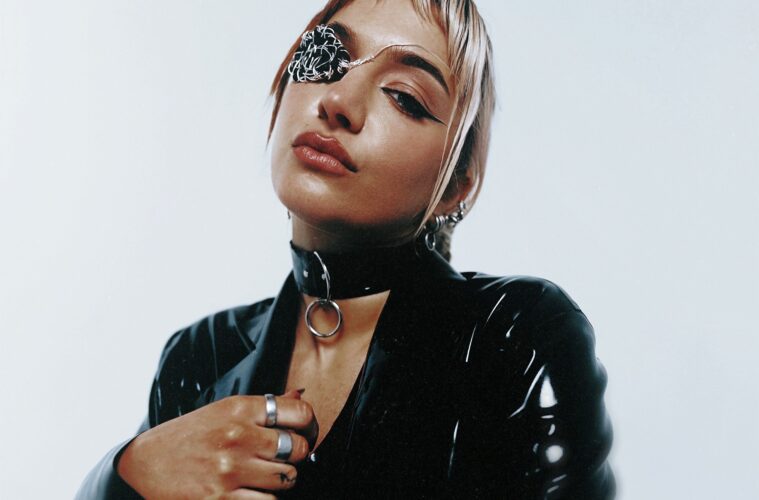Alcuni artisti fanno musica. BIIANCO costruisce mondi. Producer, cantautorə e performer formatə nel cuore del vibrante underground di Los Angeles, BIIANCO sfuma i confini tra il battito elettronico e la narrazione emotiva — creando paesaggi sonori in cui il dolore si mescola con la forza, e la vulnerabilità si trasforma in un atto di potere.
BIIANCO non si limita a pubblicare musica: si inserisce nelle scene, le plasma. La sua ultima collaborazione con “Lock It” dimostra come suono e moda possano fondersi, unendo estetica visiva e paesaggi sonori in un’armonia sorprendente.
Ha una residence su Rinse FM, dove ogni mix si trasforma in un rituale fatto di rave ad alta velocità, acid 303 e pura emozione. E poi c’è GAIA, la sua piattaforma e club experience: più di uno show, è uno spazio di inclusività radicale, liberazione catartica e performance ibrida dal vivo — dove trance, techno, acid e breakbeat si incontrano sotto un unico tetto, sudato e pieno d’amore.
Oggi entriamo nella mente dietro la musica — per parlare di suono, anima, e di tutto ciò che si trova nel mezzo dell’ universo di BIIANCO.
Ciao BIIANCO, è un grande piacere averti qui. Vorrei partire dalla tua storia personale: come hai iniziato con la musica e cosa ti ha portato a passare dalla musica classica, quando eri giovane, all’elettronica?
Ho iniziato con lezioni di pianoforte classico dai 5 anni. Da lì ho cominciato a cantare, poi ho imparato a suonare chitarra, batteria e basso. Alle superiori ho avuto il mio primo Mac, che aveva una versione base di GarageBand. Quello che era iniziato come un modo per registrare demo molto semplici delle mie canzoni è presto diventato un: «Aspetta… cos’è un compressore?!» Quel vecchio laptop e GarageBand sono stati la scintilla che ha acceso la mia passione per la produzione musicale, e da lì sono diventatə dipendente. Solo durante la pandemia, dopo essere statə a lungo in una band, ho preso una pausa dal tour e ho iniziato a scoprire rave e la scena underground. È stato allora che ho trovato il mio suono.
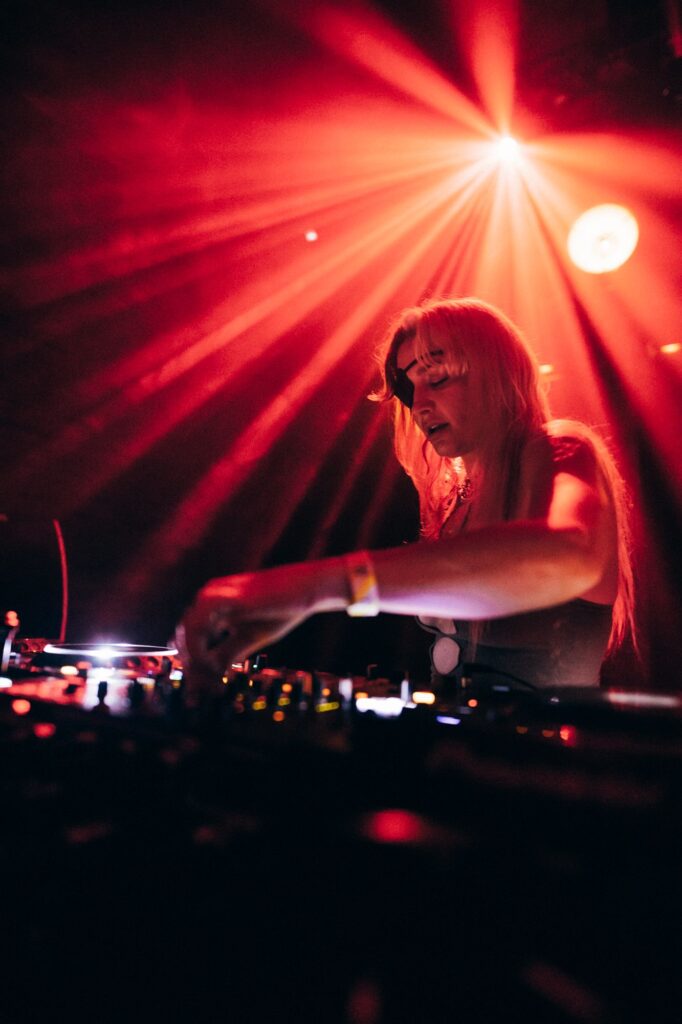
Cosa significa per te la musica e come la usi per esprimerti e connetterti con gli altri?
Onestamente, comunico e mi connetto con gli altri molto più facilmente attraverso la musica che con le parole. La musica è diventata la colonna portante del mio modo di esprimermi. Insieme all’identità visiva.
GAIA è la tua piattaforma artistica: cosa ti ha ispirato a creare GAIA e come vedi il ruolo della piattaforma nella scena della musica elettronica?
GAIA è una serata club dedicata all’hard dance, con talenti di alto livello e un focus FLINTA, che trascende i confini e connette comunità. Il nostro obiettivo è che diventi una festa riconosciuta dagli appassionati di hard trance, techno e musica dance, da Amsterdam a Londra, da Los Angeles a Melbourne. Si viene per la musica e si torna per la comunità. Sono stata molto ispirata da ciò che He.She.They hanno creato. Ovunque tu sia nel mondo, se vai a una festa HST sai di trovare DJ incredibili e un’inclusività euforica. Volevo iniziare qualcosa di simile con un focus specifico sulle line-up FLINTA e un’attenzione musicale alla parte più veloce della dance.
Come scegli gli artisti da promuovere tramite GAIA e cosa vuoi trasmettere attraverso la piattaforma? Come pensi che GAIA possa contribuire a creare uno spazio più inclusivo e celebrativo per artisti e pubblici queer, femme e marginalizzati?
Ho iniziato a organizzare le serate GAIA per tre motivi: il primo è che, nonostante la diversità di genere stia migliorando nella musica dance, sembra comunque che gli uomini non cis sperimentino meno ostacoli nella loro carriera. Ironia della sorte, questi uomini spesso si ispirano alle abilità e alla musica delle loro pari femme, non-binary o non-cis, eppure incontrano meno difficoltà nella crescita.
Volevo creare line-up attorno agli artisti FLINTA più ispiratori del sound harddance. Il secondo motivo è che ho notato come gli spazi rave spesso non siano abbastanza accessibili per i nostri ravers con disabilità. Essendo una persona ipovedente, questa cosa mi sta molto a cuore — per questo tutte le serate GAIA sono accessibili a tutte le persone con disabilità. Infine, volevo connettere comunità oltre i confini geografici. Vengo da New York, ho vissuto a Los Angeles per un decennio, ora vivo a Londra e passo molto tempo a Berlino. I miei amici e collaboratori sono così diversi e la mia musica è cresciuta molto grazie a questo. GAIA mira a superare i confini e a connettere ravers affini, riflettendo la mia stessa vita.
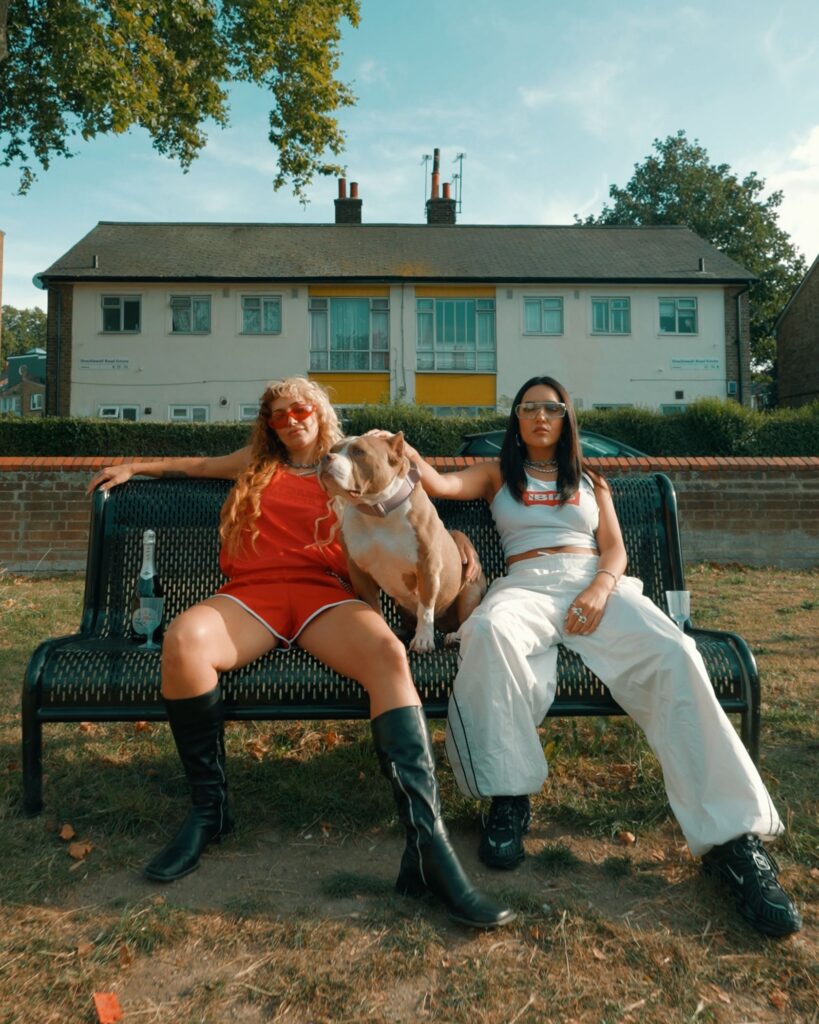
Parliamo del tuo nuovo singolo “Lock It”. Cosa ti ha ispirato a creare questo brano e come ne descriveresti il sound e l’atmosfera?
Ho studiato spagnolo per otto anni durante l’ infanzia e, sebbene riesca a parlare la lingua, ho un accento americano estremamente marcato. Avendo vissuto per un decennio nell’East LA, la cultura Chicano si è radicata profondamente nel mio cuore e nella mia anima — è probabilmente l’aspetto della California che più mi manca dopo essermi trasferito in Europa. Ultimamente, c’è stata una straordinaria esplosione di influenze spagnole e Phonk nella scena techno bouncy, e ho voluto contribuire a questo movimento in modo autentico. Ho collaborato con la mia amica Ammara, che ora vive a Londra ma è originaria della Spagna, e insieme abbiamo creato questo pezzo vivace e accattivante.
Hai scelto di usare testi in spagnolo: quale significato hanno per te la lingua e la cultura nella tua musica?
Parlo spagnolo con un accento americano decisamente buffo, quindi per rendere omaggio attraverso questa canzone abbiamo voluto farne il tema centrale. I testi significano letteralmente: “Sono così eccitato che ho iniziato a parlare questa lingua”. Ammara poi risponde nella sua lingua madre, fluente e naturale, donando al brano un’energia protettiva e materna. In sostanza, è il nostro modo di dire che lo spagnolo è incredibilmente sexy — tanto che ormai anche gli americani lo stanno parlando
Come pensi che “Lock It” verrà interpretata dal pubblico e cosa speri che le persone portino con sé dopo aver ascoltato la canzone?
Spero che ballino, si sentano sexy e inizino a correre in giro dicendo “MIRA VENGA ESCÚCHAME”.
A luglio ascolteremo il tuo nuovo singolo “Bruv Parade”: cosa puoi raccontarci sulla genesi di “Bruv Parade” e cosa ti ha ispirato a crearlo?
Continuavo a sentire tutte queste versioni remixate di Da Hool’s Love Parade, ma volevo realizzarne una che non solo rendesse omaggio a quel brano assolutamente iconico, ma che prendesse anche un po’ in giro il gran numero di remix che circolano. Ecco perché i testi sono del tipo… “oh, vuoi sentire quella cosa?”.
Come vedi il tuo ruolo come artista e promotore di altri artisti nella scena musicale?
La musica riguarda la gioia, l’espressione e le comunità che costruiamo attorno all’esperienza musicale. Il mio ruolo, come produttore e artista, è nutrire tutte e tre queste dimensioni attraverso il suono.
Cosa significa per te avere una residency su Rinse FM, e come pensi di utilizzare questa piattaforma per mostrare la tua musica e il tuo stile?
Prima di tutto, sono davvero onoratədi essere statə sceltə per una residency su Rinse. Gran parte della mia educazione nella musica dance è nata proprio ascoltando i programmi di Rinse nel corso degli anni.Tutte le mie trasmissioni hanno un tema legato a una sostanza chimica: finora abbiamo fatto Adrenalina (alta energia), Ossitocina (trance e techno profonde e ipnotiche) e recentemente Acid (acid techno con live 303). Uso ogni puntata mensile per immergermi nei sottogeneri della hard dance, mostrando la loro diversità sonora e gli artisti e le comunità che la stanno plasmando nell’underground.
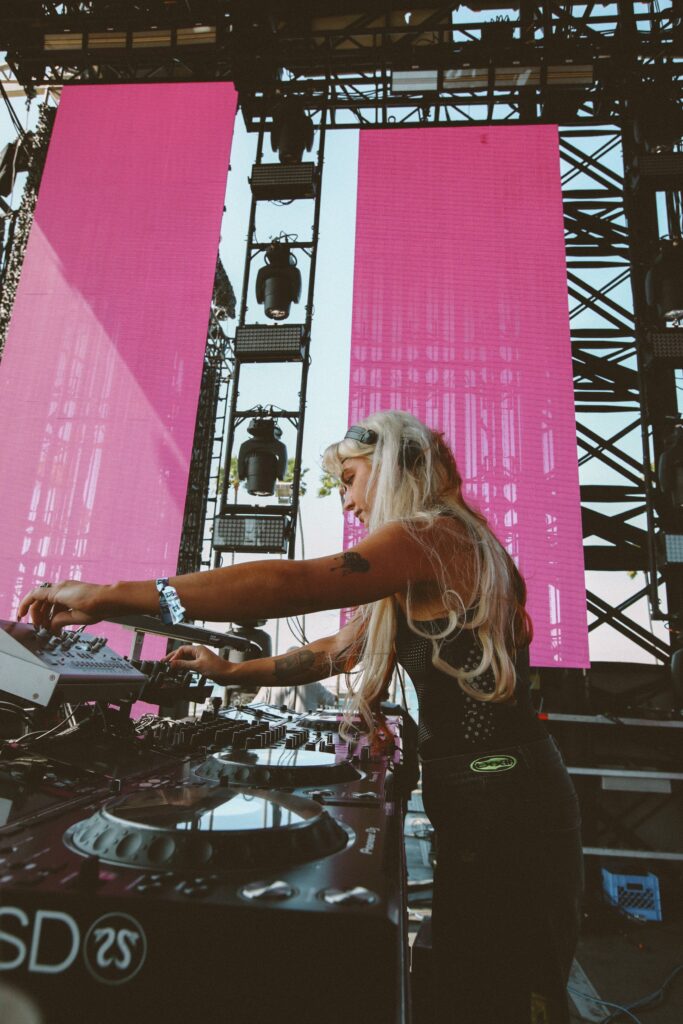
Come è cambiato il tuo approccio alla scoperta di nuova musica nel tempo, e cosa ti ispira a continuare a esplorare nuovi suoni?
Oggi trovo la musica principalmente tramite artisti che mi contattano direttamente o ascoltando i set di altri. Ho la fortuna di poter contare sulla comunità per creare una rete di “diggers”.
Se potessi esprimere un desiderio per la scena della musica elettronica, quale sarebbe e perché?
Vorrei che si smantellasse la macchina del profitto e si restituisse il potere all’underground. E che tutte le grandi multinazionali di private equity venissero estromesse dai nostri festival e rave. Sono le stesse corporazioni che finanziano le guerre, il collasso ambientale e una disuguaglianza economica enorme. Letteralmente tutto ciò da cui cerchiamo di evadere attraverso la musica.
ENGLISH VERSION
In Conversation with BIIANCO: Queer Frequencies, Club Culture, and Sonic Futures
Some artists make music. BIIANCO builds worlds.A producer, songwriter, and performer forged in the heart of Los Angeles’ vibrant underground, BIIANCO blurs the lines between electronic pulse and emotional storytelling — crafting sonic landscapes where heartbreak dances with empowerment, and vulnerability becomes a power move.
BIIANCO, doesn’t just release music — they insert themselves into scenes. Their latest collaboration with “Look It” shows how fashion and sound collide, bringing together visual aesthetics and sonic landscapes in striking harmony.
They hold a residency at Rinse FM, where every mix becomes a ritual of high-speed rave, acid 303s, and raw emotion. And then there’s GAIA, their own platform and club‑experience: more than a show, it’s a space for radical inclusivity, cathartic release, and live hybrid performance — where trance, techno, acid and breakbeat all meet under one sweaty, loving roof.
Today, we dive into the mind behind the music — to talk sound, soul, and the spaces in between.
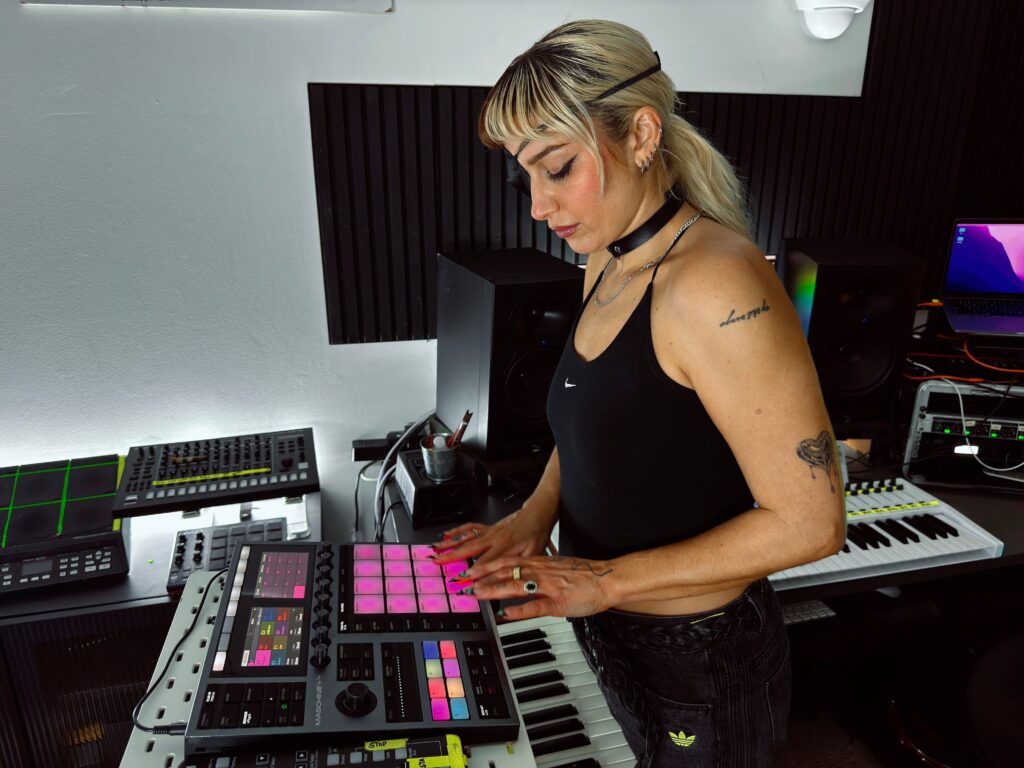
Hello BIIANCO, it’s a great pleasure to have you here. I want to start from your personal story: How did you get started with music and what led you to transition from classical music when you were young to electronic music?
I was in classical piano lessons from age 5 on. From there, I started singing, picked up guitar, drums and bass.In high school, I got my first Mac laptop and it came with a basic version of GarageBand. What started as me trying to lay down very basic demos of my song squickly became‘wait… what is a compressor?!’That little old laptop and GarageBand were the spark that ignited my music production and from there I wasaddicted.It wasn’t until the pandemic and I had been in a band for a very long time, that I took a break from touring and started to experience raves and the underground.That was when I found my sound
What does music mean to you and how do you use it to express yourself and connect with others?
Honestly, I communicate and connect with others much more easily through music than through words. Music has become the backbone for the way I express myself.That and visual identity.
GAIA is your artistic platform: what inspired you to create GAIA and how do you see the platform’s role in the electronic music scene?
GAIA is a hard dance, high talent, FLINTA-focussed club night that transcendsborders and connects communities.Our goal is for it to be a party that hard trance / techno /dance music lovers are familiar with,from Amsterdam to London to LA to Melbourne eventually. They go for the music and come back for the community. I have been really inspired by what He.She.They have created.No matter where in the world you are, if you go to a HST party, you know you’re going to get amazing DJs and euphoric inclusivity. I wanted to start that with a specifically FLINTA-focus for the line ups and a specific musical focus on the faster side of dance.
How do you choose the artists to promote via GAIA and what do you aim to convey through the platform? How do you think GAIA can contribute to creating a more inclusive and celebratory space for queer, femme, and marginalized artists and audiences?
I started throwing my GAIA parties because of three things: first one,I noticed that even though gender diversity is improving in dance music, it still feels like non-cis men experience more friction when climbing in their career. Ironically, these men are often inspired by the skill sand music of their femme / non-binary / non-cis peers and yet they encounter less obstacles when growing.I wanted to create line ups around the most inspiring FLINTA artists in the harddance sound. Second one, I also noticed that rave spaces are often not as accessible for our differently abled ravers as they should be.As a visually impaired person, this is near and dear to my experience–so all GAIA parties are accessible to all differently abled attendees.And three, I wanted to connect communities across borders.I’m from NYC, lived in LA for a decade and now live in London and spend tons of time in Berlin.My friends and collaborators are so diverse and my music has grown richer because of that. GAIA aims to transcend borders and connect like-minded ravers as a mirror to my own life.
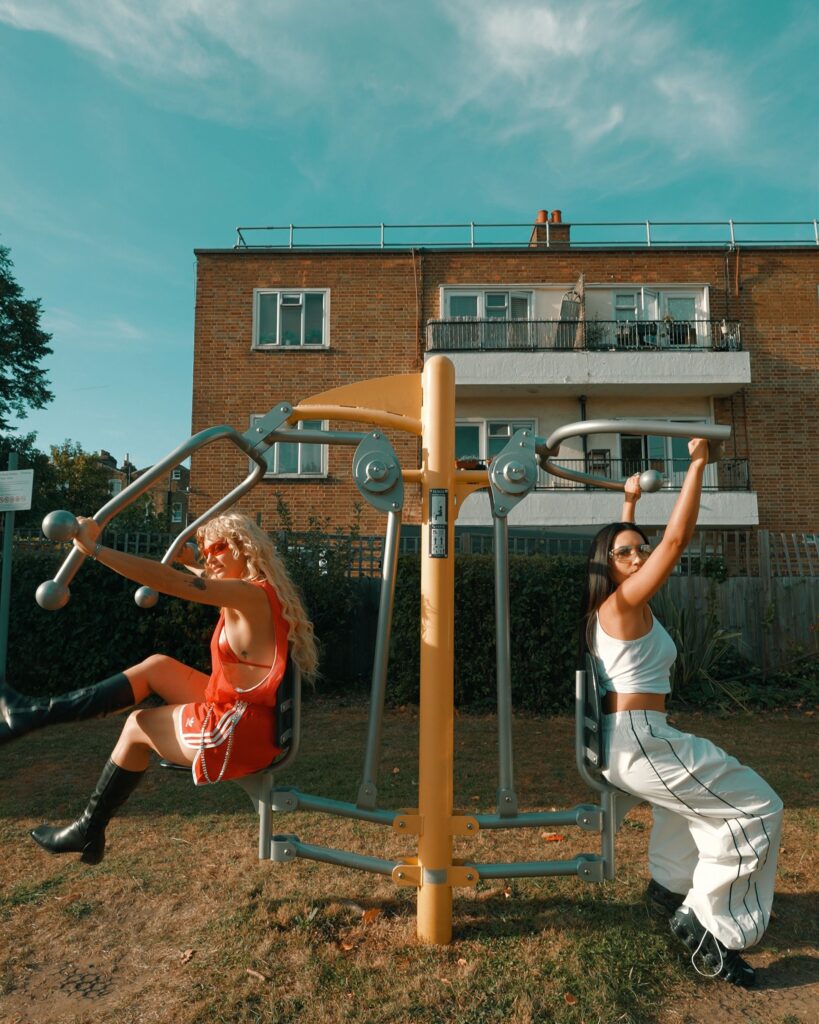
Let’s talk about your new single “Lock It”. What inspired you to create “Lock It” and how would you describe the sound and atmosphere of the song?
I studied Spanish for 8 years growing up and can speak with but have the most American accent you can imagine.Living in east LA for a decade, Chicano culturewas buried deep in my heart and soul–and it might be the thing about California I miss the most after moving to Europe. So, recently, there’s been this amazing explosion of Spanish and Phonk in the bouncy techno scene and I wanted to contribute to that authentically.I tapped my friend Ammara, who lives in London now but is originally from Spain–and we created this cute lil bouncy number.
You choose to use Spanish lyrics: what significance does the language and culture hold for you in your music?
I’m someone who speaks Spanish with a hilariously bad accent so in order for me to pay homage with this song, we wanted to center that thematically.The lyrics literally mean: “I’m so turned on I started speaking this language”–then Ammara speaks in her native fluent tongue and gives it sort of a mama bear vibe. It’s basically our way of saying Spanish is sexy as hell and we got even the Americans speaking it aha
How do you think “Lock It” will be interpreted by audiences and what do you hope people will take away from the song?
I hope they dance and feel sexy and start running around saying “MIRA VENGA ESCUCHAME”.
In july we listen to your new single “Bruv Parade”: what can you tell us about the genesis of “Bruv Parade” and what inspired you to create it?
I kept hearing all these edits of Da Hool’s Love Parade but wanted to make one that not only nodded to that absolutely iconic song but poked fun at how many edits are flying around of it. That’s why the lyrics are like… “oh you wanna hear that thing?”
How do you see your role as an artist and promoter of other artists in the music scene?
Music is about joy and expression and the communities we build around experiencing it.My role as a music producer and artist is to no urish all three of those things through sound.
What does it mean to you to have a residency at Rinse FM, and how do you plan to use this platform to showcase your music and style?
First of all, I’m really honored to have been chosen to have a residency at Rinse. A lot of my dance music education came from listening to rinse shows over the years.All my shows thematically center a chemical, so far we’ve done Adrenaline (highenergy), Oxytocin(deep, hypnotic trance and techno), and recently Acid (Acid techno with live 303)–I use the show each month to get deep into subgenres of hard dance to showcase its sonic diversity and the artists and communities that are shaping it in the underground.
How has your approach to digging and discovering new music evolved over time, and what inspires you to keep exploring new sounds?
Now, I mostly find music through artists who come to me directly or through the sets of others. I am fortunate to be able to lean on community to create diggers.
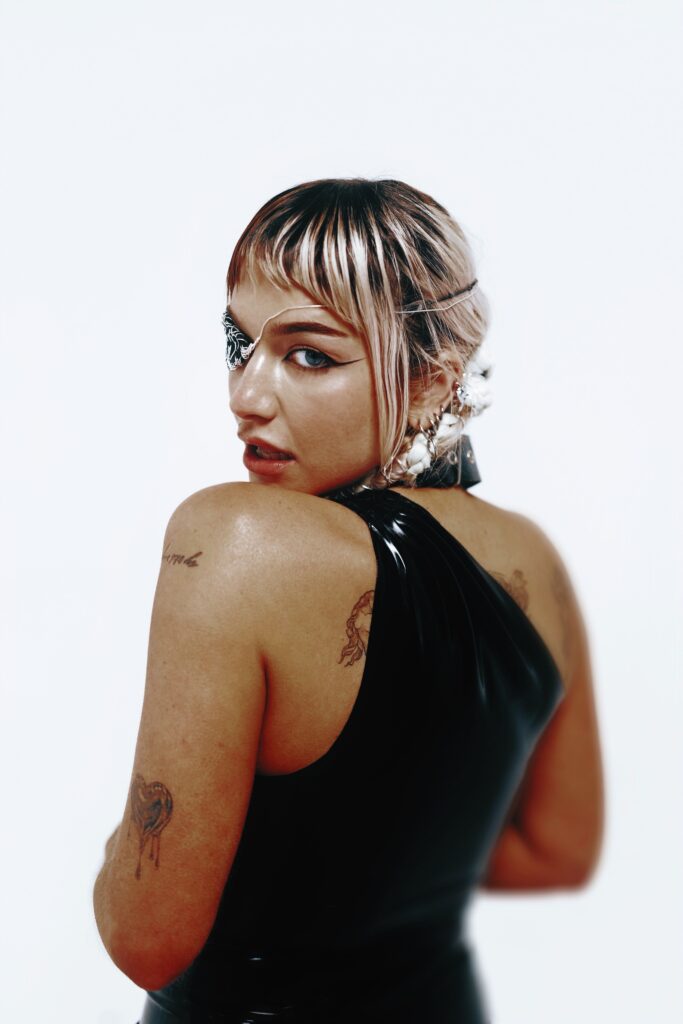
If you could make a wish for the electronic music scene, what would it be and why?
I wish we could dismantle the money-maker machine and put the power back in the hands of the underground. And to remove all private equity conglomerates from our festival sand raves.These are the same corporations funding war, the collapse of our environment and immense wealth disparity. Literally everything we turn to music to escape.
.

